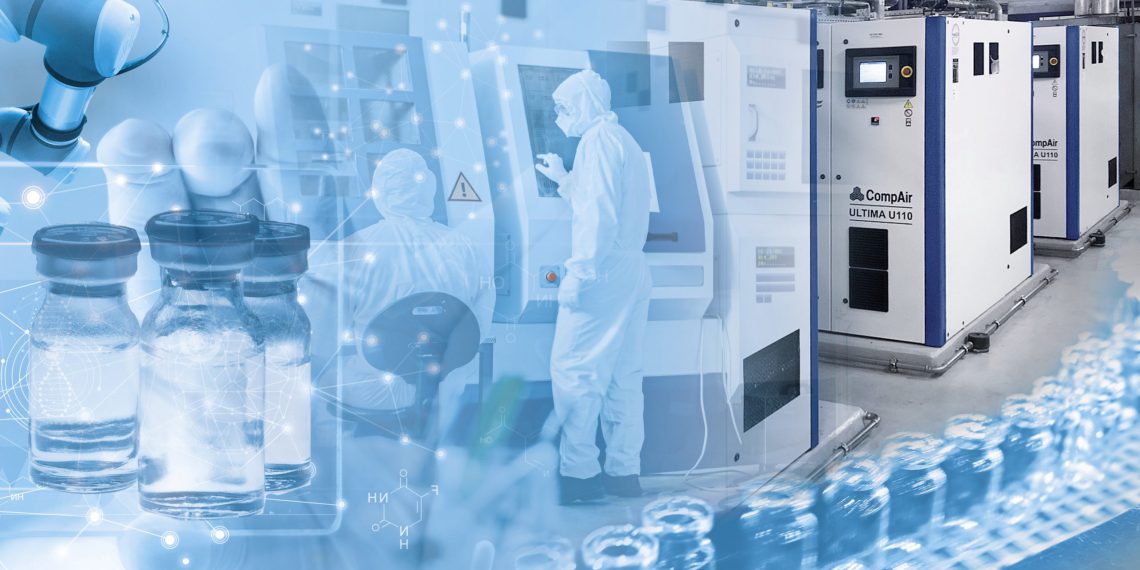Rolf Hömke, research spokesman for the German Association of Research-Based Pharmaceutical Companies (VFA), made clear what came as no surprise to those responsible for vaccine production:
“It’s one thing to produce on a small scale, it’s another thing when they have to scale up all at once.”
Increasing vaccine volumes on a scale never before practiced to contain and end the pandemic is imperative. As a result, expansions and conversions of existing production facilities are causing supply bottlenecks. On the positive side, the necessary mature technologies for expanding capacities are available. One example of this is the components for generating and treating high-purity compressed air, which is indispensable as process and working air. The use of oil-free compressors is advantageous here. Downstream treatment is then less costly.
And because the production of large quantities of vaccine also requires large quantities of additional compressed air, existing compressed air stations have to be upgraded. A new oil-free Plug & Work compressor came in handy for the companies in this situation. Its digitized drive precisely delivers the required volume flow at the specified pressure level. As compressed air demand grows, this compressor can be “upgraded” to the desired capacity within the available rated capacity range of 75 kW to 160 kW.
This is significantly more economical than investing in a new larger or additional compressor. It also eliminates downtime, delivery times and installation costs, as well as additional space requirements. In the current climate, where pharmaceutical companies are working to build up production capacity for vaccine production, this is a key argument for using CompAir’s new Ultima compressors, which are already in use at many pharmaceutical production sites around the world.
The economic benefits of extensive plug & work installation of these compact machines, which do not require complex air duct installations, are considerable. For example, approximately 37% of floor space is saved compared to conventional oil-free compressors. The retrofitting and conversion of compressed air stations, even under limited space conditions, can be easily realized. Added to this is the advantage of a sound pressure level of only 69 db(A). — This is another result of the compact gearless design, which is achieved by digitizing the drive.
Sustainability: Digitization and waste heat recovery
The low-pressure and high-pressure stages of the Ultima compressor are each driven by their own frequency-controlled high-speed permanent magnet motor. Synchronization is handled by the electronics of the frequency converter. This digital gearbox replaces the otherwise common mechanical gearbox, which loads the compressor systems with both energy and lubricants.
The result is an oil-free compressor with a higher power density, smaller installation space and less weight. The consistently maximum efficiency that can be achieved in this way leads to a reduction in energy costs of up to 13 percent. The problem of unused energy during idling of speed-controlled compressors has also been reduced. This digitized air compressor consumes up to 45 percent less power at idle than conventional two-stage compressors.
The patented closed cooling system of the compressor makes it possible to use the waste heat generated during compression to produce process hot water at usable temperatures of up to 85°C, and for the first time not only in water-cooled models but also in air-cooled models.
This pays off in the pharmaceutical industry, which has a high process heat demand for its numerous production processes. If adsorption dryers are used to achieve an optimum pressure dew point for the compressed air, part of the waste heat can also be used to regenerate the desiccant.
Conclusion: the road to mass production of vaccines to contain and end the pandemic must overcome many bottlenecks. A new digital oil-free compressor technology is helping to make retrofitting existing compressed air supply systems in vaccine production faster, more economical and more sustainable.

















